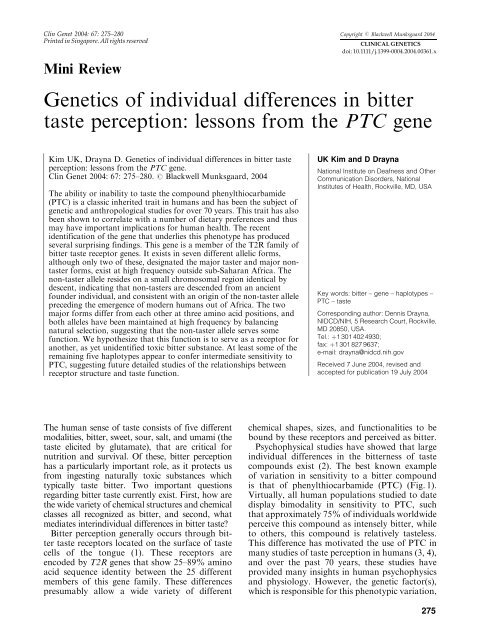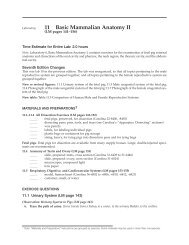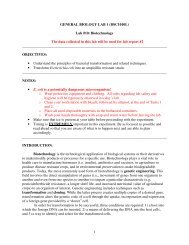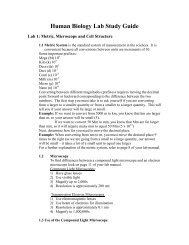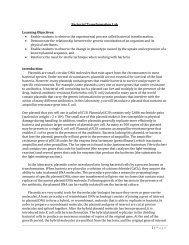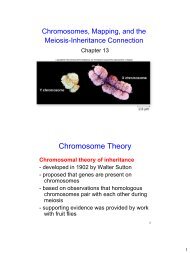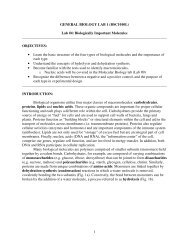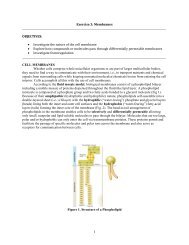Genetics of individual differences in bitter taste perception: lessons ...
Genetics of individual differences in bitter taste perception: lessons ...
Genetics of individual differences in bitter taste perception: lessons ...
You also want an ePaper? Increase the reach of your titles
YUMPU automatically turns print PDFs into web optimized ePapers that Google loves.
Cl<strong>in</strong> Genet 2004: 67: 275–280 Copyright # Blackwell Munksgaard 2004<br />
Pr<strong>in</strong>ted <strong>in</strong> S<strong>in</strong>gapore. All rights reserved<br />
CLINICAL GENETICS<br />
doi: 10.1111/j.1399-0004.2004.00361.x<br />
M<strong>in</strong>i Review<br />
<strong>Genetics</strong> <strong>of</strong> <strong><strong>in</strong>dividual</strong> <strong>differences</strong> <strong>in</strong> <strong>bitter</strong><br />
<strong>taste</strong> <strong>perception</strong>: <strong>lessons</strong> from the PTC gene<br />
Kim UK, Drayna D. <strong>Genetics</strong> <strong>of</strong> <strong><strong>in</strong>dividual</strong> <strong>differences</strong> <strong>in</strong> <strong>bitter</strong> <strong>taste</strong><br />
<strong>perception</strong>: <strong>lessons</strong> from the PTC gene.<br />
Cl<strong>in</strong> Genet 2004: 67: 275–280. # Blackwell Munksgaard, 2004<br />
The ability or <strong>in</strong>ability to <strong>taste</strong> the compound phenylthiocarbamide<br />
(PTC) is a classic <strong>in</strong>herited trait <strong>in</strong> humans and has been the subject <strong>of</strong><br />
genetic and anthropological studies for over 70 years. This trait has also<br />
been shown to correlate with a number <strong>of</strong> dietary preferences and thus<br />
may have important implications for human health. The recent<br />
identification <strong>of</strong> the gene that underlies this phenotype has produced<br />
several surpris<strong>in</strong>g f<strong>in</strong>d<strong>in</strong>gs. This gene is a member <strong>of</strong> the T2R family <strong>of</strong><br />
<strong>bitter</strong> <strong>taste</strong> receptor genes. It exists <strong>in</strong> seven different allelic forms,<br />
although only two <strong>of</strong> these, designated the major <strong>taste</strong>r and major non<strong>taste</strong>r<br />
forms, exist at high frequency outside sub-Saharan Africa. The<br />
non-<strong>taste</strong>r allele resides on a small chromosomal region identical by<br />
descent, <strong>in</strong>dicat<strong>in</strong>g that non-<strong>taste</strong>rs are descended from an ancient<br />
founder <strong><strong>in</strong>dividual</strong>, and consistent with an orig<strong>in</strong> <strong>of</strong> the non-<strong>taste</strong>r allele<br />
preced<strong>in</strong>g the emergence <strong>of</strong> modern humans out <strong>of</strong> Africa. The two<br />
major forms differ from each other at three am<strong>in</strong>o acid positions, and<br />
both alleles have been ma<strong>in</strong>ta<strong>in</strong>ed at high frequency by balanc<strong>in</strong>g<br />
natural selection, suggest<strong>in</strong>g that the non-<strong>taste</strong>r allele serves some<br />
function. We hypothesize that this function is to serve as a receptor for<br />
another, as yet unidentified toxic <strong>bitter</strong> substance. At least some <strong>of</strong> the<br />
rema<strong>in</strong><strong>in</strong>g five haplotypes appear to confer <strong>in</strong>termediate sensitivity to<br />
PTC, suggest<strong>in</strong>g future detailed studies <strong>of</strong> the relationships between<br />
receptor structure and <strong>taste</strong> function.<br />
UK Kim and D Drayna<br />
National Institute on Deafness and Other<br />
Communication Disorders, National<br />
Institutes <strong>of</strong> Health, Rockville, MD, USA<br />
Key words: <strong>bitter</strong> – gene – haplotypes –<br />
PTC – <strong>taste</strong><br />
Correspond<strong>in</strong>g author: Dennis Drayna,<br />
NIDCD/NIH, 5 Research Court, Rockville,<br />
MD 20850, USA.<br />
Tel.: þ1 301 402 4930;<br />
fax: þ1 301 827 9637;<br />
e-mail: drayna@nidcd.nih.gov<br />
Received 7 June 2004, revised and<br />
accepted for publication 19 July 2004<br />
The human sense <strong>of</strong> <strong>taste</strong> consists <strong>of</strong> five different<br />
modalities, <strong>bitter</strong>, sweet, sour, salt, and umami (the<br />
<strong>taste</strong> elicited by glutamate), that are critical for<br />
nutrition and survival. Of these, <strong>bitter</strong> <strong>perception</strong><br />
has a particularly important role, as it protects us<br />
from <strong>in</strong>gest<strong>in</strong>g naturally toxic substances which<br />
typically <strong>taste</strong> <strong>bitter</strong>. Two important questions<br />
regard<strong>in</strong>g <strong>bitter</strong> <strong>taste</strong> currently exist. First, how are<br />
the wide variety <strong>of</strong> chemical structures and chemical<br />
classes all recognized as <strong>bitter</strong>, and second, what<br />
mediates <strong>in</strong>ter<strong><strong>in</strong>dividual</strong> <strong>differences</strong> <strong>in</strong> <strong>bitter</strong> <strong>taste</strong><br />
Bitter <strong>perception</strong> generally occurs through <strong>bitter</strong><br />
<strong>taste</strong> receptors located on the surface <strong>of</strong> <strong>taste</strong><br />
cells <strong>of</strong> the tongue (1). These receptors are<br />
encoded by T2R genes that show 25–89% am<strong>in</strong>o<br />
acid sequence identity between the 25 different<br />
members <strong>of</strong> this gene family. These <strong>differences</strong><br />
presumably allow a wide variety <strong>of</strong> different<br />
chemical shapes, sizes, and functionalities to be<br />
bound by these receptors and perceived as <strong>bitter</strong>.<br />
Psychophysical studies have showed that large<br />
<strong><strong>in</strong>dividual</strong> <strong>differences</strong> <strong>in</strong> the <strong>bitter</strong>ness <strong>of</strong> <strong>taste</strong><br />
compounds exist (2). The best known example<br />
<strong>of</strong> variation <strong>in</strong> sensitivity to a <strong>bitter</strong> compound<br />
is that <strong>of</strong> phenylthiocarbamide (PTC) (Fig. 1).<br />
Virtually, all human populations studied to date<br />
display bimodality <strong>in</strong> sensitivity to PTC, such<br />
that approximately 75% <strong>of</strong> <strong><strong>in</strong>dividual</strong>s worldwide<br />
perceive this compound as <strong>in</strong>tensely <strong>bitter</strong>, while<br />
to others, this compound is relatively <strong>taste</strong>less.<br />
This difference has motivated the use <strong>of</strong> PTC <strong>in</strong><br />
many studies <strong>of</strong> <strong>taste</strong> <strong>perception</strong> <strong>in</strong> humans (3, 4),<br />
and over the past 70 years, these studies have<br />
provided many <strong>in</strong>sights <strong>in</strong> human psychophysics<br />
and physiology. However, the genetic factor(s),<br />
which is responsible for this phenotypic variation,<br />
275
Kim and Drayna<br />
NH<br />
C<br />
NH 2<br />
Fig. 1. Chemical structure <strong>of</strong> phenylthiocarbamide.<br />
S<br />
rema<strong>in</strong>ed uncharacterized until recently. In this<br />
review, we focus on our recent discovery <strong>of</strong> the<br />
PTC gene, the developments <strong>in</strong> <strong>taste</strong> physiology<br />
and population genetics that have followed, and<br />
the implications <strong>of</strong> this work for understand<strong>in</strong>g<br />
phenotypic variation <strong>in</strong> <strong>taste</strong> <strong>perception</strong> <strong>in</strong> general.<br />
sample <strong>of</strong> 100 families and suggested that PTC<br />
<strong>taste</strong> sensitivity is controlled by a major locus<br />
with <strong>in</strong>complete dom<strong>in</strong>ance, as well as by a multifactorial<br />
component with significant residual heritability.<br />
Olson et al. (10) studied 120 families and<br />
produced results that supported a two-locus<br />
model <strong>in</strong> which one locus controls PTC tast<strong>in</strong>g<br />
and the other locus controls a more general <strong>taste</strong><br />
ability. Thus, it became clear that PTC <strong>taste</strong> ability<br />
is not simply Mendelian <strong>in</strong> its transmission<br />
pattern, and rather than be<strong>in</strong>g a dichotomous<br />
trait, it displays a broad and cont<strong>in</strong>uous, albeit<br />
bimodal, distribution <strong>of</strong> <strong>taste</strong> sensitivity <strong>in</strong> the<br />
population (11).<br />
The discovery <strong>of</strong> <strong>taste</strong> bl<strong>in</strong>dness for PTC<br />
Studies on the genetics <strong>of</strong> <strong>taste</strong> <strong>perception</strong> for<br />
PTC began <strong>in</strong> the early 1930s with the accidental<br />
f<strong>in</strong>d<strong>in</strong>g by A. L. Fox that crystals <strong>of</strong> PTC <strong>taste</strong>d<br />
very <strong>bitter</strong> to some people but not to others (5, 6).<br />
This difference, which is stable over the lifetime <strong>of</strong><br />
a given <strong><strong>in</strong>dividual</strong>, was typically measured us<strong>in</strong>g<br />
PTC-saturated paper and record<strong>in</strong>g subject’s <strong>perception</strong>,<br />
either <strong>bitter</strong> or not. However, later<br />
improvements <strong>in</strong> measurement utilized a PTC<br />
dilution series and forced choice bl<strong>in</strong>d sort<strong>in</strong>g<br />
tests to determ<strong>in</strong>e an <strong><strong>in</strong>dividual</strong>’s level <strong>of</strong> PTC<br />
sensitivity. These quantitative studies showed<br />
that between the most sensitive and least sensitive<br />
<strong><strong>in</strong>dividual</strong>s, the ability to discrim<strong>in</strong>ate PTC <strong>in</strong><br />
solution varied by four orders <strong>of</strong> magnitude <strong>in</strong><br />
PTC concentration. Us<strong>in</strong>g a variety <strong>of</strong> test<strong>in</strong>g<br />
measures, researchers have made estimates <strong>of</strong><br />
the frequency <strong>of</strong> PTC ‘<strong>taste</strong>rs’ and ‘non-<strong>taste</strong>rs’<br />
<strong>in</strong> many different populations worldwide. These<br />
studies showed that although non-<strong>taste</strong>rs exist <strong>in</strong><br />
virtually all populations (the exception be<strong>in</strong>g one<br />
small group <strong>of</strong> Brazilian Indians), the frequency<br />
<strong>of</strong> such <strong><strong>in</strong>dividual</strong>s varies <strong>in</strong> different populations<br />
(3). The best studied population is Caucasians,<br />
where the frequency <strong>of</strong> non-<strong>taste</strong>rs is estimated<br />
to be approximately 28% overall.<br />
Mode <strong>of</strong> <strong>in</strong>heritance<br />
Soon after the discovery <strong>of</strong> PTC sensory variation,<br />
several <strong>in</strong>vestigators reported that this trait<br />
is <strong>in</strong>herited, and that the non-<strong>taste</strong>r phenotype<br />
was transmitted as a simple Mendelian recessive<br />
trait (7, 8). However, other studies have suggested<br />
that <strong>in</strong>complete dom<strong>in</strong>ance, multiple alleles, or<br />
multiple genes fit the <strong>in</strong>heritance <strong>of</strong> the <strong>in</strong>ability<br />
to <strong>taste</strong> PTC better than a simple Mendelian<br />
recessive model (3). In particular, Reddy and<br />
Rao (9) exam<strong>in</strong>ed <strong>in</strong>heritance patterns <strong>in</strong> a<br />
Genetic l<strong>in</strong>kage analysis<br />
L<strong>in</strong>kage evidence for PTC <strong>taste</strong> ability has a long<br />
history <strong>of</strong> conflict<strong>in</strong>g f<strong>in</strong>d<strong>in</strong>gs. Chautard-Freire-<br />
Maia (12) searched for l<strong>in</strong>kage us<strong>in</strong>g data on 22<br />
autosomal polymorphic loci collected by Morton<br />
and his colleagues (13, 14) from a northeastern<br />
Brazilian population. This study found evidence<br />
for l<strong>in</strong>kage between PTC phenotype and the KEL<br />
blood group antigen, later determ<strong>in</strong>ed to reside<br />
on chromosome 7, <strong>in</strong> the region <strong>of</strong> band q 3 . The<br />
study <strong>of</strong> Conneally et al. (15) added significant<br />
support to the evidence for l<strong>in</strong>kage to KEL, with<br />
a total comb<strong>in</strong>ed LOD score <strong>of</strong> 10.78 at y ¼ 0.045.<br />
However, a number <strong>of</strong> other studies failed to f<strong>in</strong>d<br />
significant support for this l<strong>in</strong>kage (16–18). These<br />
l<strong>in</strong>kage studies were performed assum<strong>in</strong>g recessive<br />
<strong>in</strong>heritance <strong>of</strong> the trait and assign<strong>in</strong>g subject<br />
phenotype <strong>in</strong> a dichotomous fashion as a qualitative<br />
trait, either <strong>taste</strong>r or non-<strong>taste</strong>rs. At this<br />
po<strong>in</strong>t, l<strong>in</strong>kage studies <strong>of</strong> PTC <strong>taste</strong> ability reached<br />
an impasse that was not overcome until the<br />
advent <strong>of</strong> polymorphic DNA markers and highresolution<br />
genome-wide l<strong>in</strong>kage scans.<br />
The first such l<strong>in</strong>kage scan was performed with<br />
the related compound propylthiouracil (PROP)<br />
<strong>in</strong> a Caucasian population (19). In this study,<br />
the phenotype was measured by us<strong>in</strong>g a s<strong>in</strong>gle<br />
subjective rat<strong>in</strong>g <strong>of</strong> <strong>taste</strong> <strong>in</strong>tensity with six categories<br />
<strong>of</strong> <strong>taste</strong> strength (20). In an important<br />
advance, these phenotypic data were treated as a<br />
quantitative trait and produced significant evidence<br />
<strong>of</strong> l<strong>in</strong>kage to a locus on chromosome 5p<br />
(t-score ¼ 3.28, p ¼ 0.0005), along with a suggestion<br />
<strong>of</strong> l<strong>in</strong>kage to markers on chromosome 7q31<br />
at a distance <strong>of</strong> approximately 35 cM from KEL<br />
(t-score ¼ 2.34, p ¼ 0.008). Thus, this study,<br />
employ<strong>in</strong>g a quantitative trait loci (QTL) model<br />
and genome-wide marker <strong>in</strong>formation but a<br />
slightly different <strong>taste</strong> compound, produced<br />
quite different results.<br />
276
<strong>Genetics</strong> <strong>of</strong> <strong>taste</strong> <strong>perception</strong><br />
In attempt to address this problem comprehensively,<br />
we obta<strong>in</strong>ed a quantitative measure <strong>of</strong><br />
PTC-tast<strong>in</strong>g ability us<strong>in</strong>g the modification <strong>of</strong><br />
Harris and Kalmus method (11) <strong>in</strong> 26Utah<br />
Center d’Etude du Polymorphsime d’Huma<strong>in</strong><br />
(CEPH) families, consist<strong>in</strong>g <strong>of</strong> 267 <strong><strong>in</strong>dividual</strong>s<br />
(21). With this <strong>in</strong>formation, we performed l<strong>in</strong>kage<br />
analyses with both the recessive model based<br />
on the traditional <strong>taste</strong>r and non-<strong>taste</strong>r classification<br />
<strong>of</strong> the trait and QTL us<strong>in</strong>g the full range <strong>of</strong><br />
PTC thresholds. These analyses showed repeatedly<br />
significant evidence for l<strong>in</strong>kage to chromosome<br />
7q35–36, consistent with some <strong>of</strong> the<br />
previous results provided by earlier studies (12,<br />
15). In addition, the result a <strong>of</strong> quantitative trait<br />
analysis us<strong>in</strong>g two-locus whole-genome scan conditional<br />
on the chromosome 7 QTL identified a<br />
secondary locus on chromosome 16p. Interest<strong>in</strong>gly,<br />
we observed that non-<strong>taste</strong>r phenotypes <strong>in</strong><br />
the families show<strong>in</strong>g l<strong>in</strong>kage to chromosome 7<br />
were qualitatively different from the non-<strong>taste</strong>r<br />
phenotype <strong>in</strong> other families not l<strong>in</strong>ked to chromosome<br />
7. Non-<strong>taste</strong>rs <strong>in</strong> chromosome 7-l<strong>in</strong>ked<br />
families typically reported no <strong>taste</strong> whatsoever<br />
from PTC solutions <strong>in</strong> the range reliably detected<br />
by <strong>taste</strong>rs. Non-<strong>taste</strong>rs <strong>in</strong> families show<strong>in</strong>g no<br />
l<strong>in</strong>kage to chromosome 7 <strong>of</strong>ten reported some<br />
sensation or <strong>taste</strong> other than <strong>bitter</strong> at such PTC<br />
concentrations. This implied the existence <strong>of</strong> two<br />
types <strong>of</strong> non-<strong>taste</strong>rs, consistent with previous suggestions<br />
(10).<br />
Identification <strong>of</strong> the gene underly<strong>in</strong>g PTC<br />
phenotype<br />
While many studies have supported the view that<br />
PTC sensitivity represents a Mendelian trait (7,<br />
8), it became clear that this phenotype displays<br />
many characteristics that have hampered traditional<br />
l<strong>in</strong>kage and positional clon<strong>in</strong>g studies <strong>of</strong><br />
complex traits <strong>in</strong> humans, <strong>in</strong>clud<strong>in</strong>g a cont<strong>in</strong>uously<br />
distributed phenotype, uncerta<strong>in</strong> mode <strong>of</strong><br />
<strong>in</strong>heritance, low LOD scores, and failures to<br />
replicate l<strong>in</strong>kage. This <strong>in</strong>dicated that the PTC<strong>taste</strong><br />
phenotype occupies an <strong>in</strong>termediate position<br />
between that <strong>of</strong> typical Mendelian disorders<br />
and fully complex traits. This suggested that identification<br />
<strong>of</strong> the gene(s) for this trait might provide<br />
a better understand<strong>in</strong>g <strong>of</strong> the genetics <strong>of</strong><br />
complex traits <strong>in</strong> general.<br />
Understand<strong>in</strong>g <strong>of</strong> <strong>bitter</strong> <strong>taste</strong> <strong>perception</strong> has<br />
been aided by many recent advances <strong>of</strong> <strong>in</strong> vitro<br />
studies <strong>in</strong> <strong>bitter</strong> <strong>taste</strong> <strong>perception</strong> (1, 22) and by the<br />
Human Genome Project, which has provided<br />
candidate gene <strong>in</strong>formation. With strong<br />
evidence for l<strong>in</strong>kage to chromosome 7 us<strong>in</strong>g qualitative<br />
and quantitative analyses, our group<br />
focused on identify<strong>in</strong>g the gene which resides at<br />
this locus (21, 23). Based on this, we hypothesized<br />
that the CEPH families that showed l<strong>in</strong>kage only<br />
on chromosome 7 and nowhere else <strong>in</strong> the genome<br />
were the result <strong>of</strong> a s<strong>in</strong>gle recessive gene. We<br />
then performed additional genotyp<strong>in</strong>g for highresolution<br />
l<strong>in</strong>kage and haplotype studies and<br />
undertook a detailed candidate gene search <strong>in</strong><br />
this region. In the critical l<strong>in</strong>kage <strong>in</strong>terval on<br />
chromosome 7, we found a number <strong>of</strong> T2R <strong>bitter</strong><br />
<strong>taste</strong> receptor genes, plus a number <strong>of</strong> other genes<br />
tentatively annotated as odorant receptor-like<br />
genes, which together were evaluated as lead<strong>in</strong>g<br />
candidates. Sequence analysis <strong>of</strong> these genes identified<br />
one variant <strong>in</strong> a T2R <strong>bitter</strong> receptor gene<br />
that demonstrated strong association with <strong>taste</strong><br />
phenotype <strong>in</strong> chromosome 7-l<strong>in</strong>ked CEPH<br />
families. Further analysis with an <strong>in</strong>dependent<br />
group <strong>of</strong> subjects us<strong>in</strong>g 50 s<strong>in</strong>gle nucleotide polymorphisms<br />
(SNPs) at an average spac<strong>in</strong>g <strong>of</strong> 50 kb<br />
across the <strong>in</strong>terval demonstrated strong association<br />
with phenotype and l<strong>in</strong>kage disequilibrium<br />
(LD) with<strong>in</strong> a 150-kb region <strong>of</strong> the <strong>in</strong>terval.<br />
With<strong>in</strong> this region, 35 out <strong>of</strong> 37 unrelated non<strong>taste</strong>rs<br />
were homozygous for a conserved haplotype,<br />
largely as predicted for a recessive allele.<br />
Bio<strong>in</strong>formatics and gene-f<strong>in</strong>d<strong>in</strong>g efforts with<strong>in</strong><br />
this region revealed only one gene, the T2R <strong>bitter</strong><br />
receptor gene which orig<strong>in</strong>ally showed strong<br />
association with the phenotype and LD <strong>in</strong> the<br />
Utah CEPH families.<br />
The phenotype/genotype correlation<br />
This gene, now designated as T2R38 or PTC, isa<br />
member <strong>of</strong> <strong>bitter</strong> <strong>taste</strong> receptor gene family <strong>in</strong><br />
humans (1). It consists <strong>of</strong> a s<strong>in</strong>gle cod<strong>in</strong>g exon<br />
1002 bp long, encod<strong>in</strong>g a 333 am<strong>in</strong>o acid, 7-transmembrane<br />
doma<strong>in</strong> G-prote<strong>in</strong>-coupled receptor<br />
(23). With<strong>in</strong> the gene, we identified three common<br />
SNPs, all <strong>of</strong> which result <strong>in</strong> am<strong>in</strong>o acids changes<br />
<strong>in</strong> the prote<strong>in</strong>. One <strong>of</strong> these variants, which substitutes<br />
an alan<strong>in</strong>e for a prol<strong>in</strong>e at am<strong>in</strong>o acid<br />
residue 49 (A49P), showed a strong association<br />
with <strong>taste</strong>r status <strong>in</strong> the subjects studied.<br />
We then characterized this gene <strong>in</strong> African,<br />
European, Asian, and Native Amer<strong>in</strong>dian populations,<br />
and identified five different haplotypes<br />
specified by this gene, <strong>in</strong>volv<strong>in</strong>g different comb<strong>in</strong>ations<br />
<strong>of</strong> variants at three different positions <strong>in</strong><br />
the prote<strong>in</strong> am<strong>in</strong>o acids 49 (prol<strong>in</strong>e or alan<strong>in</strong>e),<br />
262 (alan<strong>in</strong>e or val<strong>in</strong>e), and 296 (val<strong>in</strong>e or isoleuc<strong>in</strong>e).<br />
The two most common haplotypes,<br />
designated prol<strong>in</strong>e-alan<strong>in</strong>e-val<strong>in</strong>e (PAV) and<br />
alan<strong>in</strong>e-val<strong>in</strong>e-isoleuc<strong>in</strong>e (AVI), showed<br />
277
Kim and Drayna<br />
a very strong association with <strong>taste</strong> status, and PAV<br />
is now referred to as the major <strong>taste</strong>r haplotype,<br />
whileAVIisreferredtoasthemajornon-<strong>taste</strong>r<br />
haplotype. Individuals who carry two copies <strong>of</strong><br />
AVI haplotype were largely non-<strong>taste</strong>rs, whereas<br />
either one or two copies <strong>of</strong> the PAV haplotype<br />
were largely <strong>taste</strong>rs. Also, a modest heterozygote<br />
effect was apparent. As a group, PAV/AVI heterozygotes<br />
had a statistically significant higher<br />
PTC <strong>taste</strong> threshold than PAV homozygotes<br />
(p < 0.005) and thus were slightly less sensitive<br />
to PTC. In addition to the common PAV and<br />
AVI haplotypes, a third haplotype, AAV, was<br />
observed at lower frequency. When scored on a<br />
simple dichotomous measure <strong>of</strong> PTC sensitivity,<br />
AVI/AAV heterozygotes were almost evenly<br />
divided between <strong>taste</strong>rs and non-<strong>taste</strong>rs. This<br />
suggests that AAV haplotype specifies a more<br />
<strong>in</strong>termediate phenotype. Overall, this study<br />
demonstrated that these haplotypes completely<br />
expla<strong>in</strong> the bimodal distribution <strong>of</strong> PTC <strong>taste</strong><br />
sensitivity, and 55–85% <strong>of</strong>thevariance<strong>in</strong>PTC<br />
sensitivity, depend<strong>in</strong>g on the population studied.<br />
Because the mode <strong>of</strong> <strong>in</strong>heritance <strong>of</strong> PTC-<strong>taste</strong><br />
sensitivity has been a subject <strong>of</strong> controversy (3),<br />
we exam<strong>in</strong>ed the evidence for additional genetic<br />
contributions to PTC l<strong>in</strong>kage score. The results<br />
were largely consistent with a model <strong>of</strong> a major<br />
recessive QTL modified by either a polygenic or a<br />
s<strong>in</strong>gle-locus residual background effect (9, 10). It<br />
also supported the view that additional genes outside<br />
<strong>of</strong> chromosome 7q contribute to this phenotype,<br />
and that one such gene might reside on the<br />
short arm <strong>of</strong> chromosome 16(21).<br />
Population genetics and molecular evolution<br />
The f<strong>in</strong>d<strong>in</strong>gs with the T2R38 gene and PTC raised<br />
an important question. Why is the frequency <strong>of</strong> the<br />
AVI non-<strong>taste</strong>r allele so high Because our sense <strong>of</strong><br />
<strong>bitter</strong> <strong>taste</strong> is thought to protect us from <strong>in</strong>gest<strong>in</strong>g<br />
toxic substances, a non-functional allele <strong>of</strong> a <strong>bitter</strong><br />
<strong>taste</strong> receptor might be expected to be quickly<br />
elim<strong>in</strong>ated from the population by natural selection.<br />
Even though PTC itself has not been found <strong>in</strong><br />
nature, it is structurally related to a group <strong>of</strong> compounds<br />
that occur <strong>in</strong> cruciferous vegetables (e.g.<br />
cabbage, broccoli, and Brussels sprouts) and are<br />
toxic <strong>in</strong> large quantities, with the thyroid as the<br />
primary organ affected. For example, isothiocyanates<br />
and goitr<strong>in</strong> are <strong>bitter</strong> PTC-related compounds<br />
caused by hydrolysis <strong>of</strong> glucos<strong>in</strong>olates<br />
naturally present <strong>in</strong> raw cabbage (24). Variable<br />
aversions to these compounds, correlated with<br />
PTC <strong>taste</strong>r status, have been implicated <strong>in</strong> the<br />
variable rates <strong>of</strong> thyroid deficiency (25).<br />
This question has long <strong>in</strong>trigued geneticists. For<br />
example, Fisher et al. (26) tested PTC tast<strong>in</strong>g <strong>in</strong><br />
chimpanzees and found that the proportion <strong>of</strong><br />
non-<strong>taste</strong>rs is approximately the same as <strong>in</strong><br />
humans (approximately 30%). They speculated<br />
that the existence <strong>of</strong> this phenotypic polymorphism<br />
<strong>in</strong> both humans and apes would have not<br />
occurred without natural selection, and they proposed<br />
that balanc<strong>in</strong>g selection has ma<strong>in</strong>ta<strong>in</strong>ed<br />
both <strong>taste</strong>r and non-<strong>taste</strong>r alleles <strong>in</strong> the population.<br />
Such hypotheses, however, have been difficult<br />
to test without knowledge <strong>of</strong> the gene<br />
encod<strong>in</strong>g this trait.<br />
Recently, Wood<strong>in</strong>g et al. (27) performed a<br />
global survey <strong>of</strong> the PTC gene <strong>in</strong> a sample <strong>of</strong><br />
165 <strong><strong>in</strong>dividual</strong>s collected from African, Asian,<br />
European, and North Amer<strong>in</strong>dian populations,<br />
along with apes for comparison. In addition to<br />
the three common SNPs found previously, two<br />
rare human variants were identified only <strong>in</strong><br />
populations <strong>of</strong> African orig<strong>in</strong>, one at am<strong>in</strong>o acid<br />
position 80 and one at position 274. Together,<br />
these five cod<strong>in</strong>g SNPs specify seven different<br />
haplotypes <strong>in</strong> the worldwide population. Furthermore,<br />
this study revealed that the two major<br />
<strong>taste</strong>r and non-<strong>taste</strong>r haplotypes, which account<br />
for >90% <strong>of</strong> all chromosomes (23), were found at<br />
<strong>in</strong>termediate frequencies across all populations.<br />
The chimpanzee and gorilla were both homozygous<br />
at all nucleotide positions and thus carried one<br />
haplotype each, which was the PAV type, analogous<br />
to human <strong>taste</strong>rs. Human and chimpanzee<br />
sequences differed by an average <strong>of</strong> 8.3 nucleotides<br />
as did human and gorilla sequences <strong>in</strong>dicat<strong>in</strong>g the<br />
high similarity between human and the great apes.<br />
Measurement <strong>of</strong> genetic differentiation between<br />
the cont<strong>in</strong>ental population samples by use <strong>of</strong> F ST<br />
statistics showed that this was low (F ST ¼ 0.056)<br />
<strong>in</strong> comparison with estimates based on other<br />
genes. Different tests <strong>of</strong> natural selection <strong>in</strong>clud<strong>in</strong>g<br />
Tajima’s D demonstrated a significant deviation<br />
from neutrality because <strong>of</strong> an excess <strong>of</strong><br />
<strong>in</strong>termediate-frequency variants when human<br />
population growth was taken <strong>in</strong>to account. The<br />
high Tajima’s D-value along with a low F ST value<br />
supported the hypothesis that balanc<strong>in</strong>g natural<br />
selection has acted to ma<strong>in</strong>ta<strong>in</strong> ‘<strong>taste</strong>r’ and ‘non<strong>taste</strong>r’<br />
alleles at the PTC gene <strong>in</strong> humans. The<br />
estimated divergence date <strong>of</strong> two common haplotypes<br />
was approximately 1.5 million years under<br />
the assumption that the nucleotide substitution<br />
rate <strong>in</strong> PTC is 10 9 /site/year, although this conclusion<br />
rema<strong>in</strong>s uncerta<strong>in</strong> because <strong>of</strong> small number<br />
<strong>of</strong> mutations and the limited resource <strong>of</strong><br />
chimpanzee data.<br />
It now appears that balanc<strong>in</strong>g natural selection<br />
has ma<strong>in</strong>ta<strong>in</strong>ed divergent PTC alleles <strong>in</strong> human<br />
278
<strong>Genetics</strong> <strong>of</strong> <strong>taste</strong> <strong>perception</strong><br />
populations, but the mechanism by which this<br />
happens still needs to be resolved. Given the fact<br />
that the alterations present <strong>in</strong> the non-<strong>taste</strong>r allele<br />
are not obvious null mutations, one possibility is<br />
that the PTC non-<strong>taste</strong>r allele encodes a receptor<br />
that is fully functional for a different but as yet<br />
unknown <strong>bitter</strong> toxic substance.<br />
Applications<br />
Understand<strong>in</strong>g <strong>of</strong> the multiple sequence variations<br />
<strong>in</strong> the PTC gene will allow exam<strong>in</strong>ation <strong>of</strong><br />
the details <strong>of</strong> the genetic basis <strong>of</strong> food preferences<br />
and the relationship between <strong>bitter</strong> <strong>taste</strong> sensitivities<br />
and possible health outcomes.<br />
Identification <strong>of</strong> the PTC gene and studies <strong>of</strong> its<br />
molecular evolution have revealed a number <strong>of</strong><br />
different aspects that must be considered together<br />
<strong>in</strong> future studies <strong>of</strong> the genes responsible for <strong>in</strong>ter<strong><strong>in</strong>dividual</strong>s’<br />
difference <strong>in</strong> <strong>bitter</strong> <strong>taste</strong> sensitivity.<br />
First, unlike PTC, PROP, and related compounds,<br />
the distribution <strong>of</strong> <strong>taste</strong> thresholds for<br />
other <strong>bitter</strong> compounds typically shows unimodal<br />
distribution. Second, although natural selection<br />
has acted to ma<strong>in</strong>ta<strong>in</strong> both <strong>taste</strong>r and non-<strong>taste</strong>r<br />
alleles at the PTC locus, it is not clear whether<br />
this phenomenon has occurred for other <strong>bitter</strong><br />
<strong>taste</strong> receptor genes. To understand this <strong>in</strong> a better<br />
way, we will need to exam<strong>in</strong>e variation <strong>in</strong> the<br />
entire T2R gene family across populations, which<br />
will help human history <strong>in</strong> <strong>bitter</strong> <strong>taste</strong> <strong>perception</strong><br />
and enable creation <strong>of</strong> comprehensive functional<br />
repertoires <strong>of</strong> each gene for studies <strong>of</strong> phenotype/<br />
genotype correlations.<br />
On a larger scale, the PTC gene may be illustrative<br />
<strong>of</strong> ancient genetic variation that has been proposed<br />
to underlie common disease <strong>in</strong> modern<br />
populations. The PTC non-<strong>taste</strong>r allele is common,<br />
both because it is very old and because it appears<br />
to confer selective advantage, at least <strong>in</strong> the heterozygote<br />
state. This supports the ‘common diseasecommon<br />
variant’ hypothesis and suggests that<br />
greater study <strong>of</strong> relatively older African populations<br />
could reap important benefits <strong>in</strong> the search<br />
for variation that underlies common disease.<br />
F<strong>in</strong>ally, PTC presents a unique opportunity <strong>in</strong><br />
the field <strong>of</strong> <strong>bitter</strong> <strong>taste</strong> transduction. Hav<strong>in</strong>g a<br />
known gene with a strong effect on phenotype <strong>in</strong><br />
vivo provides many opportunities for studies <strong>of</strong><br />
<strong>taste</strong> physiology, biochemical function, and<br />
molecular structure elucidation <strong>in</strong> the human<br />
sense <strong>of</strong> <strong>taste</strong>.<br />
Acknowledgements<br />
We thank Dr Andrew Griffith and Dr Konrad Noben-Trauth<br />
for helpful comments on the manuscript, and Dr M. Leppert,<br />
Dr H. Coon, Dr E. Jorgenson, Dr N. Risch, Dr S. Wood<strong>in</strong>g,<br />
Dr M. J. Bandshad, and Dr L. Jorde and Miss J. Larsen,<br />
together with the NIH research volunteers for their contributions<br />
to these studies. This work was supported by the NIH,<br />
NIDCD Z01-000046-06.<br />
References<br />
1. Adler E, Hoon MA, Mueller KL, Chandrashekar J, Ryba NJ,<br />
Zuker CS. A novel family <strong>of</strong> mammalian <strong>taste</strong> receptors.<br />
Cell 2000: 100: 693–702.<br />
2. Delwiche JF, Buletic Z, Bresl<strong>in</strong> PA. Covariation <strong>in</strong> <strong><strong>in</strong>dividual</strong>s’<br />
sensitivities to <strong>bitter</strong> compounds: evidence support<strong>in</strong>g<br />
multiple receptor/transduction mechanisms. Percept Psychophys<br />
2001: 63: 761–776.<br />
3. Guo SW, Reed DR. The genetics <strong>of</strong> phenylthiocarbamide<br />
<strong>perception</strong>. Ann Hum Biol 2001: 28: 111–142.<br />
4. Tepper BJ. 6-n-Propylthiouracil: a genetic marker for <strong>taste</strong>,<br />
with implications for food preference and dietary habits.<br />
Am J Hum Genet 1998: 63: 1271–1276.<br />
5. Fox AL. Six <strong>in</strong> ten ‘<strong>taste</strong>bl<strong>in</strong>d’ to <strong>bitter</strong> chemical. Sci News<br />
Lett 1931: 9: 249.<br />
6. Fox AL. The relationship between chemical constitution<br />
and <strong>taste</strong>. Proc Natl Acad Sci USA 1932: 18: 115–120.<br />
7. Blankeslee AF, Salmon MR. Odor and <strong>taste</strong>-bl<strong>in</strong>dness.<br />
Eugen News 1931: 16: 105–110.<br />
8. Snyder LH. Inherited <strong>taste</strong> deficiency. Science 1931: 74:<br />
151–152.<br />
9. Reddy BM, Rao DC. Phenylthiocarbamide <strong>taste</strong> sensitivity<br />
revisited: complete sort<strong>in</strong>g test supports residual family<br />
resemblance. Genet Epidemiol 1989: 6: 413–421.<br />
10. Olson JM, Boehnke M, Neiswanger K, Roche AF,<br />
Siervogel RM. Alternative genetic models for the <strong>in</strong>heritance<br />
<strong>of</strong> the phenylthiocarbamide <strong>taste</strong> deficiency. Genet<br />
Epidemiol 1989: 6: 423–434.<br />
11. Kalmus H. Improvements <strong>in</strong> the classification <strong>of</strong> the <strong>taste</strong>r<br />
genotypes. Ann Hum Genet 1958: 222–230.<br />
12. Chautard-Freire-Maia EA. L<strong>in</strong>kage relationships between<br />
22 autosomal markers. Ann Hum Genet 1974: 38: 191–198.<br />
13. Morton NE. Genetic Studies <strong>of</strong> Northeastern Brazil. Cold<br />
Spr<strong>in</strong>g Harb Symp Quant Biol 1964: 29: 69–79.<br />
14. Morton NE, Krieger H, Mi MP. Natural selection on polymorphisms<br />
<strong>in</strong> northeastern Brazil. Am J Hum Genet 1966:<br />
18: 153–171.<br />
15. Conneally PM, Dumont-Driscoll M, Huntz<strong>in</strong>ger RS,<br />
Nance WE, Jackson CE. L<strong>in</strong>kage relations <strong>of</strong> the loci for<br />
Kell and phenylthiocarbamide <strong>taste</strong> sensitivity. Hum Hered<br />
1976: 26: 267–271.<br />
16. Crandall BF, Spence MA. L<strong>in</strong>kage relations <strong>of</strong> the<br />
phenylthiocarbamide locus (PTC). Hum Hered 1974: 24:<br />
247–252.<br />
17. Holt HA, Thompson JS, Sanger R, Race RR. L<strong>in</strong>kage<br />
relations <strong>of</strong> the blood group genes <strong>of</strong> man. Heredity 1952:<br />
6: 213–216.<br />
18. Spence MA, Falk CT, Neiswanger K et al. Estimat<strong>in</strong>g the<br />
recomb<strong>in</strong>ation frequency for the PTC-Kell l<strong>in</strong>kage. Hum<br />
Genet 1984: 67: 183–186.<br />
19. Reed DR, Nanthakumar E, North M, Bell C, Bartoshuk LM,<br />
Price RA. Localization <strong>of</strong> a gene for <strong>bitter</strong>-<strong>taste</strong> <strong>perception</strong><br />
to human chromosome 5p15. Am J Hum Genet 1999: 64:<br />
1478–1480.<br />
20. Green BG, Shaffer GS, Gilmore M. Derivation and evaluation<br />
<strong>of</strong> a semantic scale <strong>of</strong> oral sensation magnitude with<br />
apparent ratio properties. Chem Senses 1993: 18: 683–702.<br />
21. Drayna D, Coon H, Kim UK et al. Genetic analysis <strong>of</strong> a<br />
complex trait <strong>in</strong> the Utah Genetic Reference Project: a<br />
279
Kim and Drayna<br />
major locus for PTC <strong>taste</strong> ability on chromosome 7q and a<br />
secondary locus on chromosome 16p. Hum Genet 2003:<br />
112: 567–572.<br />
22. Bufe B, H<strong>of</strong>mann T, Krautwurst D, Raguse JD, Meyerh<strong>of</strong><br />
W. The human TAS2R16receptor mediates <strong>bitter</strong> <strong>taste</strong> <strong>in</strong><br />
response to beta-glucopyranosides. Nat Genet 2002: 32:<br />
397–401.<br />
23. Kim UK, Jorgenson E, Coon H, Leppert M, Risch N,<br />
Drayna D. Positional clon<strong>in</strong>g <strong>of</strong> the human quantitative<br />
trait locus underly<strong>in</strong>g <strong>taste</strong> sensitivity to phenylthiocarbamide.<br />
Science 2003: 299: 1221–1225.<br />
24. Fenwick GR, Heaney RK, Mull<strong>in</strong> WJ. Glucos<strong>in</strong>olates and<br />
their breakdown products <strong>in</strong> food and food plants. Crit Rev<br />
Food Sci Nutr 1983: 18: 123–201.<br />
25. Drewnowski A, Rock CL. The <strong>in</strong>fluence <strong>of</strong> genetic <strong>taste</strong> markers<br />
on food acceptance. Am J Cl<strong>in</strong> Nutr 1995: 62: 506–511.<br />
26. Fisher RA, Ford EB, Huxley J. Taste-test<strong>in</strong>g the anthropoid<br />
apes. Nature 1939: 144: 750.<br />
27. Wood<strong>in</strong>g S, Kim UK, Bamshad MJ, Larsen J, Jorde LB,<br />
Drayna D. Natural selection and molecular evolution <strong>in</strong><br />
PTC, a <strong>bitter</strong>-<strong>taste</strong> receptor gene. Am J Hum Genet 2004:<br />
74: 637–646.<br />
280


